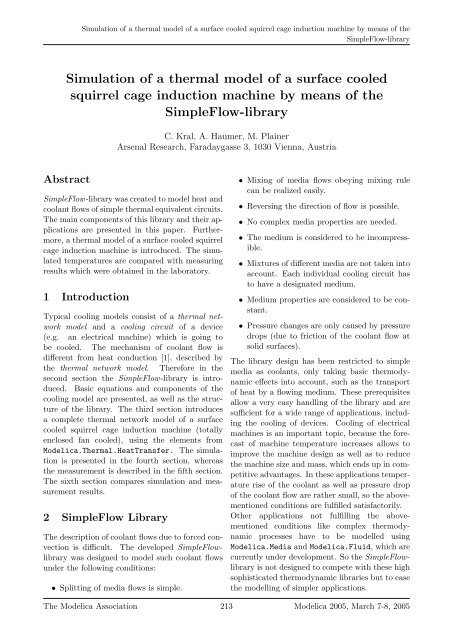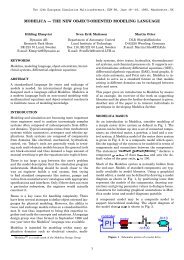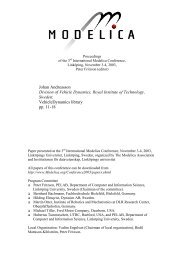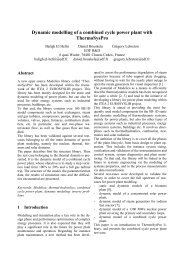Simulation of a thermal model of a surface cooled squirrel cage ...
Simulation of a thermal model of a surface cooled squirrel cage ...
Simulation of a thermal model of a surface cooled squirrel cage ...
You also want an ePaper? Increase the reach of your titles
YUMPU automatically turns print PDFs into web optimized ePapers that Google loves.
<strong>Simulation</strong> <strong>of</strong> a <strong>thermal</strong> <strong>model</strong> <strong>of</strong> a <strong>surface</strong> <strong>cooled</strong><br />
<strong>squirrel</strong> <strong>cage</strong> induction machine by means <strong>of</strong> the<br />
SimpleFlow-library<br />
Abstract<br />
<strong>Simulation</strong> <strong>of</strong> a <strong>thermal</strong> <strong>model</strong> <strong>of</strong> a <strong>surface</strong> <strong>cooled</strong> <strong>squirrel</strong> <strong>cage</strong> induction machine by means <strong>of</strong> the<br />
SimpleFlow-library<br />
C. Kral, A. Haumer, M. Plainer<br />
Arsenal Research, Faradaygasse 3, 1030 Vienna, Austria<br />
SimpleFlow-library was created to <strong>model</strong> heat and<br />
coolant flows <strong>of</strong> simple <strong>thermal</strong> equivalent circuits.<br />
The main components <strong>of</strong> this library and their applications<br />
are presented in this paper. Furthermore,<br />
a <strong>thermal</strong> <strong>model</strong> <strong>of</strong> a <strong>surface</strong> <strong>cooled</strong> <strong>squirrel</strong><br />
<strong>cage</strong> induction machine is introduced. The simulated<br />
temperatures are compared with measuring<br />
results which were obtained in the laboratory.<br />
1 Introduction<br />
Typical cooling <strong>model</strong>s consist <strong>of</strong> a <strong>thermal</strong> network<br />
<strong>model</strong> and a cooling circuit <strong>of</strong> a device<br />
(e.g. an electrical machine) which is going to<br />
be <strong>cooled</strong>. The mechanism <strong>of</strong> coolant flow is<br />
different from heat conduction [1], described by<br />
the <strong>thermal</strong> network <strong>model</strong>. Therefore in the<br />
second section the SimpleFlow-library is introduced.<br />
Basic equations and components <strong>of</strong> the<br />
cooling <strong>model</strong> are presented, as well as the structure<br />
<strong>of</strong> the library. The third section introduces<br />
a complete <strong>thermal</strong> network <strong>model</strong> <strong>of</strong> a <strong>surface</strong><br />
<strong>cooled</strong> <strong>squirrel</strong> <strong>cage</strong> induction machine (totally<br />
enclosed fan <strong>cooled</strong>), using the elements from<br />
Modelica.Thermal.HeatTransfer. The simulation<br />
is presented in the fourth section, whereas<br />
the measurement is described in the fifth section.<br />
The sixth section compares simulation and measurement<br />
results.<br />
2 SimpleFlow Library<br />
The description <strong>of</strong> coolant flows due to forced convection<br />
is difficult. The developed SimpleFlowlibrary<br />
was designed to <strong>model</strong> such coolant flows<br />
under the following conditions:<br />
• Splitting <strong>of</strong> media flows is simple.<br />
• Mixing <strong>of</strong> media flows obeying mixing rule<br />
can be realized easily.<br />
• Reversing the direction <strong>of</strong> flow is possible.<br />
• No complex media properties are needed.<br />
• The medium is considered to be incompressible.<br />
• Mixtures <strong>of</strong> different media are not taken into<br />
account. Each individual cooling circuit has<br />
to have a designated medium.<br />
• Medium properties are considered to be constant.<br />
• Pressure changes are only caused by pressure<br />
drops (due to friction <strong>of</strong> the coolant flow at<br />
solid <strong>surface</strong>s).<br />
The library design has been restricted to simple<br />
media as coolants, only taking basic thermodynamic<br />
effects into account, such as the transport<br />
<strong>of</strong> heat by a flowing medium. These prerequisites<br />
allow a very easy handling <strong>of</strong> the library and are<br />
sufficient for a wide range <strong>of</strong> applications, including<br />
the cooling <strong>of</strong> devices. Cooling <strong>of</strong> electrical<br />
machines is an important topic, because the forecast<br />
<strong>of</strong> machine temperature increases allows to<br />
improve the machine design as well as to reduce<br />
the machine size and mass, which ends up in competitive<br />
advantages. In these applications temperature<br />
rise <strong>of</strong> the coolant as well as pressure drop<br />
<strong>of</strong> the coolant flow are rather small, so the abovementioned<br />
conditions are fulfilled satisfactorily.<br />
Other applications not fulfilling the abovementioned<br />
conditions like complex thermodynamic<br />
processes have to be <strong>model</strong>led using<br />
Modelica.Media and Modelica.Fluid, which are<br />
currently under development. So the SimpleFlowlibrary<br />
is not designed to compete with these high<br />
sophisticated thermodynamic libraries but to ease<br />
the <strong>model</strong>ling <strong>of</strong> simpler applications.<br />
The Modelica Association 213 Modelica 2005, March 7-8, 2005
















